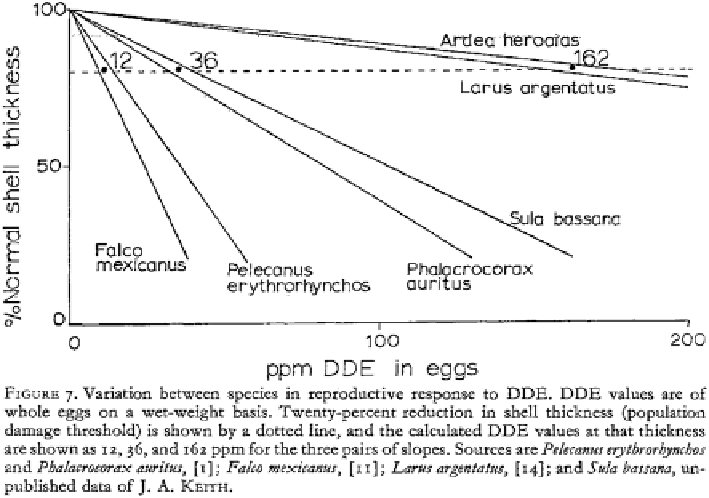Environmental Engineering Reference
In-Depth Information
Fig. 16
Species variation in eggshell thinning in response to DDE egg residues. Figure 7 in Keith
and Gruchy (
1972
) reproduced with permission
pelican eggs by gulls whenever nests were unattended. The source of DDE was
attributed to the Los Angeles outfall. The dose-response for DDE in eggs and shell
thinning is presented in Fig.
17
(DDE concentration in ppm lipid).
Blus et al. (
1974a
) reported on studies of brown pelican eggs collected in 1969
and 1970 from California, Florida and South Carolina. Eggshells were thinner than
pre-DDT era eggshells. DDE residues were highest in California eggs and lowest in
Florida eggs. Shell thinning was highly correlated with levels of DDE in the eggs.
The calculated no-effect level was 500 ppb DDE. Thinning was 4% at 1 ppm and
15% at 5 ppm. The observed logarithmic relationship was also reported by others
for the double-crested cormorant and the prairie falcon. Dieldrin may have contrib-
uted to reproductive failure of brown pelicans. Serious population declines have
occurred in California and South Carolina as a result of DDE eggshell thinning.
“The 17% eggshell thinning observed in South Carolina was associated with sub-
normal reproductive success.” In areas with the greatest eggshell thinning, “Usually,
the entire clutch exhibited the extreme thinning, and all the eggs were broken in
some nests.” Florida eggs from different breeding areas averaged 0.69-2.48 ppm
DDE, with an average of 8% shell thinning. “…the bulk of the residues in all areas
of Florida are low enough that one would not expect these residues to induce wide-
spread, long-term, adverse effects on the populations there.” The log-linear relationship
between DDE residues in eggs and shell thinning is illustrated in Fig.
18
below.
A more systematic study was done in 1971 and 1972 by Blus et al. (
1974b
) in a
breeding colony of brown pelicans in South Carolina. One freshly laid egg was

Search WWH ::

Custom Search